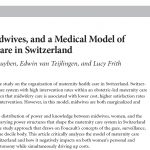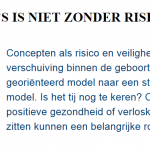 On Friday January 22nd 2016 FHSS Prof. Edwin van Teijlingen delivered a keynote address at the Annual Research Conference of the Dutch Midwifery Schools. The Dutch name for the event is ‘conferentie kennispoort’, in English ‘conference knowledge portal’ OR in a slightly different translation ‘conference knowledge gate’. The presentation aimed to get midwives, maternity care researchers and midwifery students and others in the audience to think differently about the world in which they work / practise. Prof. Edwin van Teijlingen used notions of a social versus a medical model in his talk. These are based on a number of sociology and midwifery publications of this concept over the past decade.[1-4]
On Friday January 22nd 2016 FHSS Prof. Edwin van Teijlingen delivered a keynote address at the Annual Research Conference of the Dutch Midwifery Schools. The Dutch name for the event is ‘conferentie kennispoort’, in English ‘conference knowledge portal’ OR in a slightly different translation ‘conference knowledge gate’. The presentation aimed to get midwives, maternity care researchers and midwifery students and others in the audience to think differently about the world in which they work / practise. Prof. Edwin van Teijlingen used notions of a social versus a medical model in his talk. These are based on a number of sociology and midwifery publications of this concept over the past decade.[1-4] 
Sociologists recognise two different approaches or philosophies as first a social model and, secondly, a medical model of childbirth. The social model stresses that childbirth is a physiological event that takes place in most women’s lives. The medical model highlights that childbirth is potentially pathological (or risky). In the latter view every pregnant woman is potentially at risk, hence she should deliver her baby in an obstetric hospital with its high-technology screening equipment supervised by obstetricians, the experts when something goes seriously wrong in childbirth. In other words, pregnancy and childbirth are only safe in retrospect.
References:
- Bryers, HM, van Teijlingen E (2010) Risk, Theory, Social & Medical Models: a critical analysis of the concept of risk in maternity care, Midwifery 26: 488-96.
- Ireland, J., van Teijlingen, E. (2013) Normal birth: social-medical model, The Practising Midwife 16 (11): 17-20.
- van Teijlingen E (2005) Models of pregnancy and childbirth: A sociological analysis of the medical model, Sociol Res Online 10 (2) www.socresonline.org.uk/10/2/teijlingen.html
- van Teijlingen E (2015) Sociology of Midwifery. In: Sociology for Midwives Deery R, et al. (eds.) Cambridge: Polity Press, 22-37.
 New paper international midwifery
New paper international midwifery Midwifery models in the Netherlands
Midwifery models in the Netherlands










 Fourth INRC Symposium: From Clinical Applications to Neuro-Inspired Computation
Fourth INRC Symposium: From Clinical Applications to Neuro-Inspired Computation Writing policy briefs
Writing policy briefs Upholding Excellence: The Concordat to Support Research Integrity
Upholding Excellence: The Concordat to Support Research Integrity Today’s Documentation Will Serve Tomorrow’s Justice
Today’s Documentation Will Serve Tomorrow’s Justice ECR Funding Open Call: Research Culture & Community Grant – Application Deadline Friday 12 December
ECR Funding Open Call: Research Culture & Community Grant – Application Deadline Friday 12 December MSCA Postdoctoral Fellowships 2025 Call
MSCA Postdoctoral Fellowships 2025 Call ERC Advanced Grant 2025 Webinar
ERC Advanced Grant 2025 Webinar Horizon Europe Work Programme 2025 Published
Horizon Europe Work Programme 2025 Published Horizon Europe 2025 Work Programme pre-Published
Horizon Europe 2025 Work Programme pre-Published Update on UKRO services
Update on UKRO services European research project exploring use of ‘virtual twins’ to better manage metabolic associated fatty liver disease
European research project exploring use of ‘virtual twins’ to better manage metabolic associated fatty liver disease